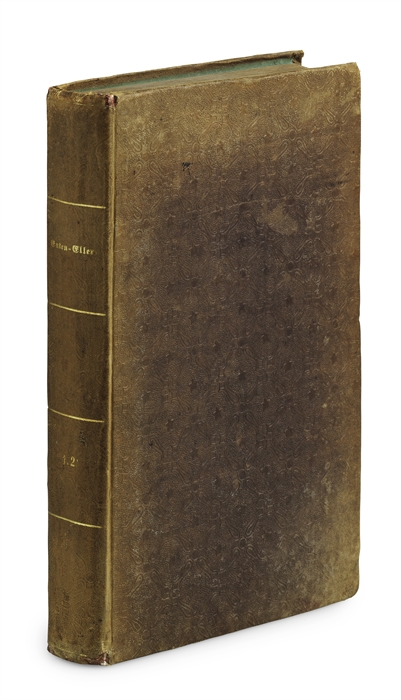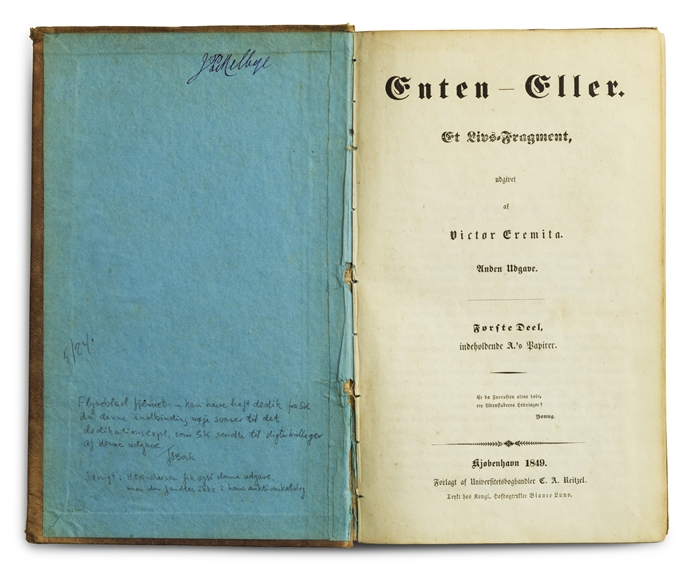IN PRESENTATION-BINDING, ONE OF SIX COPIES ON THIN VELLUM-PAPER
KIERKEGAARD, SØREN.
Enten – Eller. Et Livs=Fragment udgivet af Victor Eremita. Anden Udgave. Første Deel, indeholdende A.’s Papirer + Anden Deel, indeholdende B.’s Papirer, Breve til A.
Kjøbenhavn, Reitzel, 1849.
8vo. XIV, (2), 320; (4), 250 pp. Bound in one original full patterned cloth binding with gilt lines to spine as well as title in Gothic gilt lettering and gilt volume-numbering (“1.2.”). Printed on thin vellum-paper. Capitals and corners with a bit of wear. Spine and edges of boards a bit faded. But overall very nice. Blue pasted-down end-papers. Internally very nice and clean.
Old owner’s signature to inside of front board (J.P. Melbye) and previous owner’s neat pencil annotations explaining that the front free end-paper has been removed, that it may well have carried an inscription from Kierkegaard, and that the binding corresponds to the bindings of the copies that we know he gave away.
The important second edition (recte issue) in Kierkegaard’s own characteristic presentation-binding, one of the six copies on thin vellum-paper (although we can find mention of seven presentation-copies having been given away, Kierkegaard notes himself that he had six copies printed on special paper). There is no doubt that the present copy is in Kierkegaard’s gift- (or presentation-) binding, which he had made in the same style for the copies that he gave away. He always wrote the presentation-inscription on the front free end-paper, which is unfortunately lacking here, so that we cannot determine, to whom he gave the present copy. The binding corresponds to the one that gave to e.g. Henrik Hertz (which still has the presentation-inscription). Kierkegaard’s magnum opus Either-Or is considered the foundational work of existentialism and doubtlessly the most famous work by the greatest Scandinavian philosopher of all times, who "is now generally considered to be, however eccentric, one of the most important Christian philosophers" (PMM 314). Kierkegaard's monumental magnum opus seminally influenced later as well as contemporary philosophy and ranks as one of the most important works of philosophy of modern times. Either-Or is the earliest of Kierkegaard’s major works and the work with which he begins his pseudonymous authorship. Kierkegaard’s pseudonymity is an entire subject unto its own. The various cover names he uses play a significant role in his way of communicating and are essential to the understanding of his philosophical and religious messages. And it all properly begins here, with his groundbreaking magnum opus. Conjuring up two distinctive figures with diverging beliefs and modes of life – the aesthetic “A” of Part One, and the ethical B (note that this is the first “pseudonym” that Kierkegaard uses, in his earliest articles – no. I above)/Judge Vilhelm of Part Two, Kierkegaard presents us with the most basic reflections on the search for a meaningful existence, seen from two completely different philosophical views. This masterpiece of duality explores the foundational conflict between the ethical and the aesthetical, providing us along the way with the now so famous contemplations on music (Mozart), drama, boredom, pleasures, virtues, and, probably most famously, seduction (and rejection – The Seducer’s Diary). It is primarily Judge Vilhelm from Part Two of Either-Or that has bestowed upon Kierkegaard the reputation as the Father of Existentialism. His emphasis on taking ownership of oneself and the importance of making choices has made him the (first) personification of Existentialism and the idea that one does not passively develop into the self that he or she should be or ought to become. Kierkegaard went to great lengths to ensure that the public would not know the identity of the author was of Either-Or. He even had the draft of the work done by several hands, so that employees at the printer’s would also be deceived. Despite his efforts, however, it did not take long for the public to guess that Kierkegaard had written this astounding work. But Kierkegaard himself kept up the façade and did not accept authorship until several years later. Nothing Kierkegaard did was left to chance, which his carefully chosen pseudonyms also reflect. This also spills over in his presentation-inscriptions, which follow as strict a pattern as the pseudonyms themselves – he never signed himself the author, if his Christian name was not listed as the author on the title-page. And seeing that he had not accepted authorship of Either-Or and is not mentioned by name anywhere on the title-page (also not as the editor nor publisher as with the other pseudonymous works), he was not able to give away copies of his magnum opus, which is why no presentation-copy of the first edition exists. The appearance of the second edition of this monumental work was, naturally, carefully planned. Either-Or first appeared in 1843, and due to the great demand for the work, which had originally only been printed in ca 525 copies, it had quickly been sold out; but Kierkegaard refused to have it reprinted. In 1849, finally, he decided to let it appear again, in a textually unchanged version. When the second edition appeared (recte second issue), Kierkegaard had meanwhile owned up to the authorship of Either-Or. He had done so in 1846, in his Concluding Unscientific Postscript to The Philosophical Fragments (own translation): “For the sake of manners and etiquette I hereby acknowledge, what can hardly in reality be of interest to anybody to know, that I am, as one says, the author of Either-Or (Victor Eremita), Copenhagen in February 1843...”. Now, finally, Kierkegaard could give away his magnum opus! In his Papers from 1849, Kierkegaard states (own translation): “The poets here at home each received a copy of Either-Or. I thought it my duty; and now I was able to do it; because now one cannot reasonably claim that a conspiracy is made concerning the book. -because the book is now old and its crisis over. Of course they were given the copy from Victor Eremita...” (Pap., X1A 402). Naturally, because “as little as I in Either-Or is the Seductor or the Assessor, as little am I the publisher Victor Eremita, exactly as little; he is a poetically-real subjective thinker, as he is also found in “in vino veritas.” “ (the postscript to the Postscript, 1846) But he only sent few copies to very choice people, fewer than he did most of his other works, and only three copies have been identified (to Henrik Hertz, Christian Winther, and Hans Christian Andersen). Three further copies in gift-bindings corresponding to these have been identified, but in these copies, the leaf with the presentation-inscription has also been torn out. He must have given away yet another copy – one presumably not being on vellum-paper, as, according to his own notes, he had asked the printers for six copies on vellum paper (see Pap., Vol. X, part five, p. (203).) -, making the total known (albeit not all identified) number of copies seven. “Two copies in a binding corresponding to Hertz’s copy have been traced, but in both, the front free end-paper has been torn out. It leads one to think that the completely unusual presentation inscription (signed by Victor Eremita!), for the immediate posterity has been of such a curious nature that it has tempted autograph hunters on several occasions.” (Tekstspejle, p. 97, translated from Danish). “The other book, of which the recipients stand out is the second edition of Either-Or, which appeared in May 1849. The first edition from 1843 had been sold out for several years, but Kierkegaard had refused to have it reprinted. In our context we must remember that in 1843, he was unable to send gift copies of the first edition… When, in 1843, he lets Either-Or be reprinted in textually unaltered form, he has meanwhile (1846) admitted to authorship of the work. But the wording on the title-pages of the two leaves does not allow him to sign the dedication “from the Author” or “from the publisher” or the like.” (Tekstspejle p. 96, translated from Danish). Either-Or is now not only the title of Kierkegaard’s most famous and widely read work, it is also a phrase that summarizes much of the thinking for which he is best known and a cornerstone of what we now characterize as Existentialism. The first edition caused a sensation. The second issue (termed “edition”, although it is textually unaltered) is not only the first edition of the work to appear after Kierkegaard had acknowledged authorship of it and thus also confirmed being one and the same with his most famous pseudonym, it is also the first of Kierkegaard’s works to appear in a second edition or issue. The second edition of the work is thus also of the utmost importance and is one of the only important second editions of any of Kierkegaard’s works. PMM: 314 Himmelstrup 21 The present copy is no. 15 in Girsel's "Kierkegaard" (The Catalogue) which can be found here.
Order-nr.: 62134


